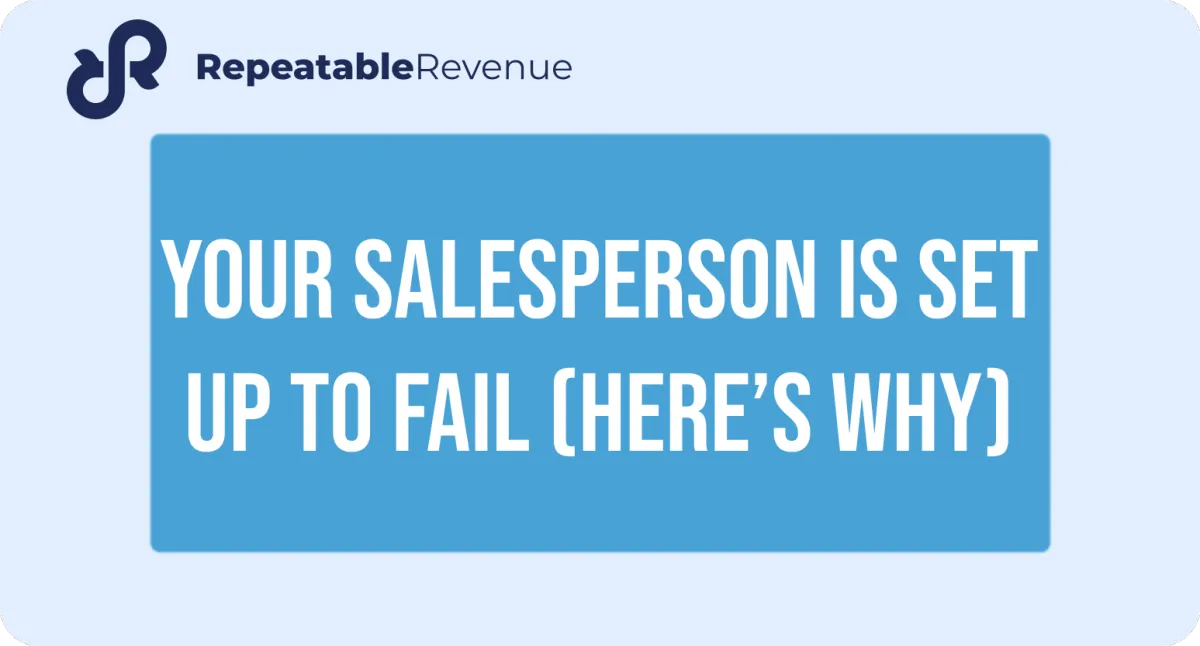
RR#145 - Your Salesperson is Set Up to Fail (Here’s Why)
Most business owners hire sales reps too soon, then wonder why they don’t get results. Before you make that hire, here’s what you need to have in place.
Hiring a Sales or Business Development Rep (SDR/BDR) sounds like a dream when you’re juggling a million things in your business.
You imagine a rockstar salesperson stepping in, taking all the prospecting off your plate, and watching revenue skyrocket while your calendar frees up.
And to be fair, it can work this way. In fact, it’s why we’ve started recruiting for the first SDR hire in my MSP Sales Partners business.
But before you pull the trigger, ask yourself: Do you actually know what they’re going to do all day?
I know it sounds crazy, but the reality is that most business owners don’t think this through.
They hire a new salesperson before they’re ready, get upset when they don’t see results, and either start the process all over or abandon the strategy altogether.
Either way the result is the same: no growth.
To avoid that (and maximize your investment), here’s what you need to have in place before you hire.
1. Define Their Daily and Weekly Activities
Can you clearly map out what a successful SDR’s day or week looks like? If not, you’re not ready to hire.
Some companies create a structured calendar that breaks down exactly what a perfect week looks like for an SDR:

Others use a tiered task list, prioritizing high-value activities first. For example:

Whichever method you use, be specific.
Your SDR should know exactly what success looks like on a daily level.
2. Show Them How to Execute
It’s one thing to say, “Here’s a list of leads, go get ‘em.” It’s another to show them exactly how to do it well.
Do you have:
Scripts for outreach and follow-ups?
SOPs or checklists for their workflow?
Training videos demonstrating key activities?
To make this easy, you can simply record a video of yourself doing the actual task. That serves as a standard operating procedure (SOP) for the activity.
For more nuanced tasks, like evaluating lists of leads to determine who is qualified and who isn’t, create a few videos where you talk about what you're looking at and how you think about it.
The point is to remove the guesswork and accelerate ramp-up time.
3. Define What Success Looks Like
If you can’t measure it, you can’t improve it. Before hiring, you want to define exactly what success means in quantifiable terms.
That means clarifying the outcomes you are expecting as well as demonstrating the inputs that are required to achieve them.
The 3 questions you want to ask are:
Does your SDR know how many appointments they have to hit every month to keep their job?
Do they know exactly how many [emails/calls/DMs] they need to execute to hit that number?
Is that number realistic?
For example, if your minimum standard is 1 new appointment per day from outbound phone calls, you can work that backwards:
1 booked call requires 5 pitches to decision makers
5 pitches to decision makers requires 70 connections
70 connections requires 100 phone calls
Simplifying it like this shows exactly what success looks like.
It also helps them concentrate on what they can control: their own efforts. While they can't control the result of every call, they can control how many calls they make, emails they send, or doors they knock on.
It’s important to note, though, that if these numbers aren’t realistic, no one wins. So, have you proven this math out on your own or elsewhere?
If not, take the time to do it yourself, or prove this math out another way. Otherwise, you’ll waste months chasing an unachievable goal.
The Cost of Doing This Wrong
Hiring an SDR without this level of clarity is a recipe for wasted time, lost money, and frustration. Many business owners rush the hire, then end up backtracking when they realize they weren’t prepared.
But when done right? It can change the trajectory of your business.
Take an IT business as an example. If their average client is worth $3,500/month and stays for five years, that’s a $210,000 lifetime value.
If an SDR generates just a handful of new opportunities per month and even a fraction convert, the ROI is massive.
The key is being prepared before hiring so your SDR isn’t set up to fail.
If you’re preparing to hire an SDR or other salesperson and have questions, reply with any questions you have and I’ll do my best to get you a reply this week.
Adios,
Ray
P.S. - Are you a badass salesperson looking to join a great team? If so, maybe you’d be a good fit here with us.
We’re looking for a talented, experienced, and hard ass working SDR/BDR teammate to join us and maintain our inbound/outbound prospecting activities (75%) as well as provide support to other SDRs in our SDR Sales Champions program (25%).
A few basic requirements:
You’ve got to love sales
3+ years of SDR, BDR, or Setter experience
Outbound phone prospecting & cold call experience
Effective copywriting skills for DM and email conversations
Experience in B2B sales preferred, bonus if it’s been in the IT industry
Most importantly, we are looking for someone dedicated to this role. We aren’t looking for this to be someone’s side hustle, or for us to be one of several clients you’re working with. We are building a dedicated team.
We’re agnostic to location, but standard business hours in US Mountain time is a non-negotiable.
If this is you, reply with a <3 minute video telling us a little about yourself and why you’re interested.
Or, if you know someone who may be a perfect fit, send ‘em this email. 🙂
